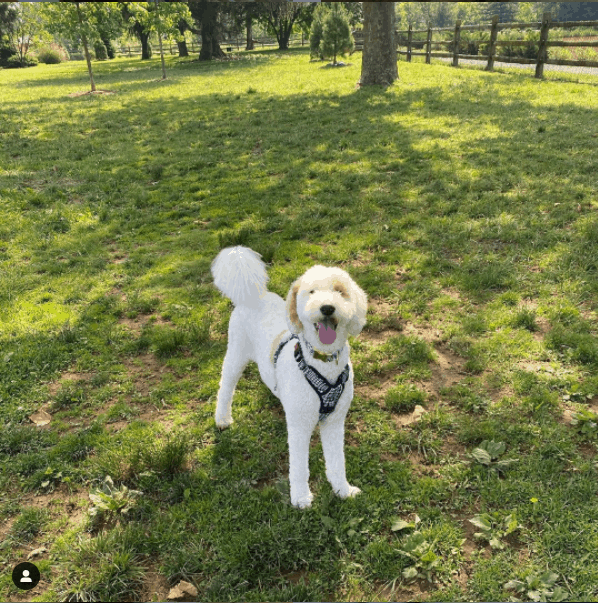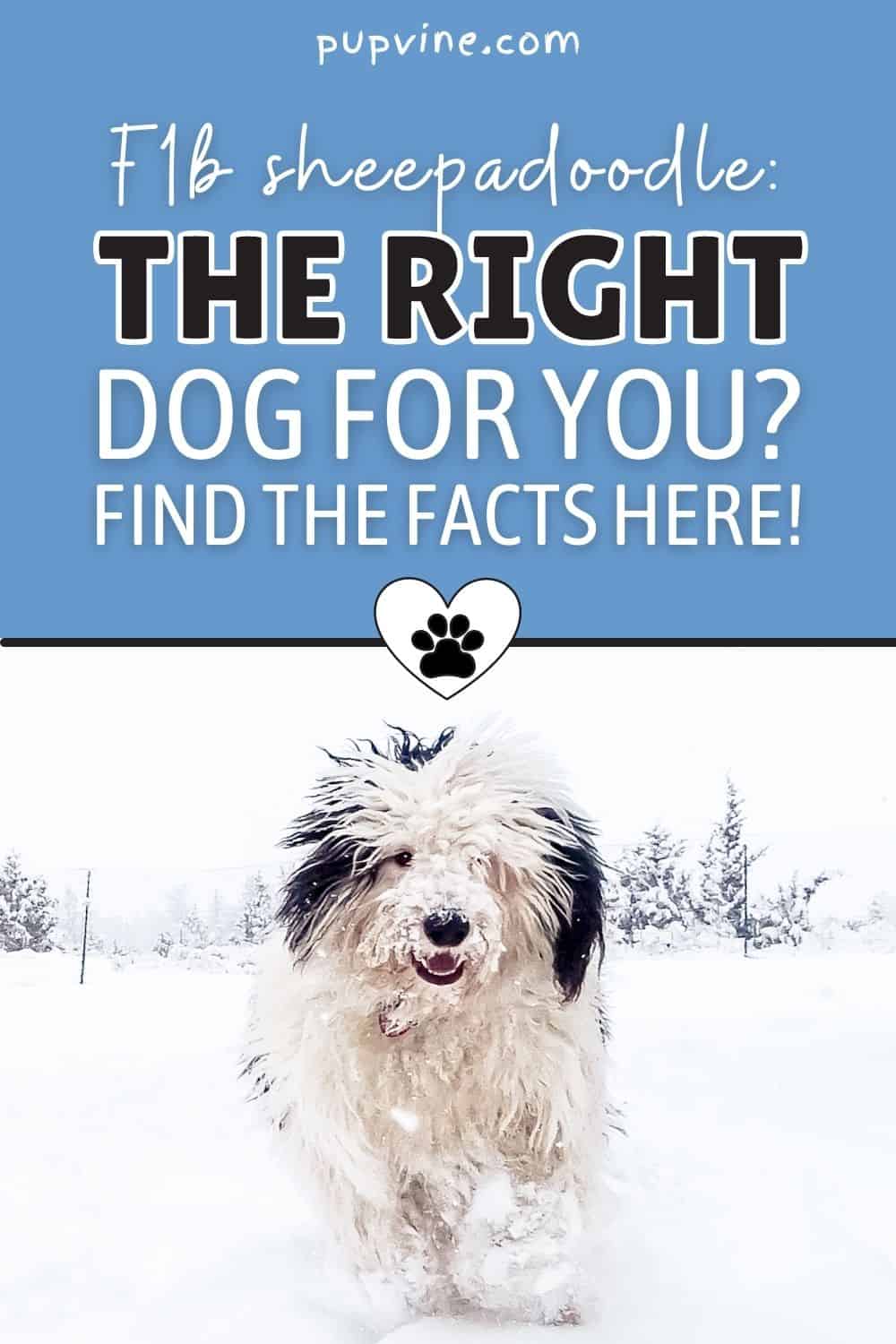When we look at all the different dog breeds around the world, it’s sometimes difficult to accept that all of them are direct descendants of the grey wolf. Selective breeding has produced some quirky results, and few of them look anything like their ancestors!
Mixing these breeds has also produced some interesting new names, with the Sheepadoodle being a good case in point.
Basically, it’s a cross between an Old English Sheepdog and a Standard Poodle, with all the loveable characteristics and charm of both breeds.
As for the name, it could have been any combination of the two, but Sheepadoodle seems to have become the most popular, though other variants, such as sheep-a-poo, sheepoodle, sheeppoo, are sometimes used.
Perhaps you’re considering getting one, and you need to know whether they make a good ‘family dog.’ Before doing so, it’s a good idea to learn all about the breed to help you decide.
So let’s have a look at what makes Sheepadoodles so popular.
The Best Of Both Breeds

Humans first began breeding dogs when they realized that different qualities could be passed on genetically.
At first, they probably didn’t fully understand why, but they knew enough to see that dogs could be selected for their strength, ferocity, courage, hunting abilities, herding instincts, and so on.
These days, breeding is no different in some aspects, but it has become finely tuned and more scientific.
Dogs are usually bred for their appearance rather than for working purposes, although some breeds still retain ancient instincts.
Most ‘working dogs’ will be used on farms or be selected as service dogs or therapy dogs, where their amazing abilities will be put to good use.
Both of the breeds that make a sheepadoodle bring unique qualities that have been gained over many generations. Here’s a quick breakdown of each breed.
The Old English Sheepdog (OES) has been around as a breed for about 200 years, often used to drive livestock over long distances to market in the UK. Their distinctive ambling gait was developed through generations of ‘droving.’
They were large enough to deter their distant cousins, the European wolf (though these had long been hunted to extinction in the UK by this time), and were excellent herders, probably inheriting these traits from continental sheep herding breeds.
Despite being originally bred as working dogs, they are famous for having a sense of humor. They are smart and mischievous and often need a firm hand when training.
Poodles, on the other hand, were originally bred as retrievers in the 1800s, especially where water was involved, which is where the name originated (from the German, pudel, which means splash, and is where the English word puddle comes from).
They are also highly intelligent, but, unlike the OES, they are easier to train.
They are known for their sense of fun and are always eager to please. Poodles require a lot of exercise and mental stimulation. Without these, they easily become bored and can develop bad habits.
Over the years, three types have emerged; the Toy Poodle, Miniature Poodle, and the Standard Poodle. Despite the size, they are all prized for the hypoallergenic qualities of their curly coat.
As with the OES, early socialization is key to get them used to other people, animals, and their care and grooming routine.
What Is An F1b Sheepadoodle?

Breeding can be a complex process, resulting in many different ‘backcross’ breeds, depending on the genes of the parent dogs.
The name given to each breed helps identify the genetic makeup, which will determine the character traits, type of coat, and the colors you might expect to see.
The breed names can be confusing, especially when new ones are introduced. Having started with the F1, we now have the F1b, F1bb, F2, F2bb, F3, and even a mini Sheepadoodle!
But what does this all mean? Well, the letter ‘F’ stands for ‘Filial hybrid,’ which basically means they are a crossbreed and not a purebred dog, and the ‘b’ means ‘backcross.’
To keep it simple, let’s start with the F1, which is when a purebred Old English Sheepdog is crossed with a purebred Standard Poodle. Then, to make the F1b, we mate an F1 with a purebred Old English Sheepdog. Easy, right?
The F1, therefore, will take an even 50% of its genetic makeup from each parent, whereas the F1b will be 75% Poodle and only 25% OES.
This is the same selective breeding process that gives us such charming breeds as Goldendoodles and Bernedoodles, combining the best qualities of each.
What About Coloring?
As you might expect, this largely depends on the parents. Most will be black and white (parti colored, essentially meaning that they are two-tone), though you can find solid black, solid white, apricot, cream, gray, gold, brown, and even red!
What Qualities Will My F1b Sheepadoodle Have?
One of the main benefits of this crossbreed is that it is good news for people with severe allergies. Although it’s impossible to have a truly 100% hypoallergenic dog (some people are allergic to dog saliva rather than the fur!), Poodles have long been regarded as allergy-friendly.
F1b Sheepadoodles inherit this trait, with a low-shedding, curly or wavy coat. They produce far less dander, which is one of the leading causes of dog allergies. The curlier the coat, the better (in terms of allergies), but keep in mind that it will require a lot of grooming! The fur can easily become matted because they don’t shed, so they will need regular brushing and/or clipping.
If you’re not prepared (or able) to do this at home, then frequent trips to the groomers may be an expense you’d need to take into account.
In terms of personality, they will be mostly Poodle, with endless energy and excitement. They’ll constantly crave attention and will need plenty of exercise and mental stimulation. When bored, they will find something to amuse themselves with, which generally means chewing up the contents of your home or barking non-stop.
One of the upsides of this backcross breed is that they are generally healthier and less prone to the genetic defects that plague most purebred dogs. Because of this, you can expect a lifespan of around 12 years.
The size of your dog will depend on the parents, with two main sizes available: Medium and Standard Sheepadoodle, but on average, they weigh between 45–80lbs, with a height ranging from thirteen to twenty-eight inches.
Mini f1 b Sheepadoodles are rare, usually produced on-demand as a designer dog, but on the whole, the larger dogs are more popular. Their good-natured gentle humor, coupled with an infectious sense of fun and boundless energy, makes this teddy-bear breed a hit with families everywhere, keeping them in high demand.
This is fascinating when you consider that the Sheepadoodle breed was first developed as a military dog by the American Army!
Are They ‘High Maintenance’?

Assuming you are planning to get your puppy from a breeder (although these dogs do occasionally turn up in shelters or Doodle rescue centers!), you should expect to pay anywhere between $2,000 to $4,000, or possibly more.
That’s a fair amount of money by anyone’s standard and a serious financial commitment. But no matter the cost, each and every one of our furry friends deserves the very best.
They are more than ‘just a pet’ and should be treated as part of the family.
Money matters aside, your biggest commitments are going to be grooming and exercise.
The majority of Sheepadoodle puppies have long, wavy coats, but your F1b will most likely have a tight curl. Matting is a real problem because they don’t shed naturally, and the matted fur can be painful.
You must be prepared to brush them three or four times a week to keep them clean, dirt-free, and to avoid matting. If you can’t do this, then a professional groomer is another option, albeit an expensive one!
Exercise should ideally be split into a couple of thirty-minute sessions each day. If you jog in the morning, great! Your energetic pal will be only too happy to join you.
Later in the day, they’d relish the chance of playtime in the backyard or a local park, letting off enough steam to keep them satisfied until the next day.

Photo from: @marvelousmaisienj
Having performed zoomies for a good half hour, they’ll be content to snuggle down on their bed, but more likely on you!
If you have a pool at home, or access to lakes, rivers, or the coast, then you can be sure that they’ll try to dive in whenever possible as they love the water.
Just be careful to limit this to occasional dips as it can cause skin problems.
They love the company of humans (especially kids) and are eager to please — which is their poodle genes showing through. Because of this, it’s never a good idea to leave them home alone for too long.
They really don’t like it and will find ways to let you know. Always try to leave a family member at home with them if you can.
Be sure to train your pup as early as possible as they are intelligent but can sometimes be wilful. This applies to socialization as well.
Although they are great fun to be around and like to act the clown for you, when they are really young, they can be a bit ‘nippy,’ more out of playful exploration than viciousness.
They may also be inclined to ‘herd’ children or pets! This is just their natural instincts kicking in, but it pays to get them used to being around other animals or humans before the biting and herding becomes an annoying habit.
So, Is The F1b Sheepadoodle The Right Dog For You?
Are you prepared to give them the love, attention, and care that they need and deserve?
As with any pet, there will be the inevitable vet bills (though hopefully not many!), sleepless nights, or days filled with worry. This is all part of the package when you care for any animal.
You’ll need the right equipment and the right food. You’ll need to research the right food to ensure you are giving them a healthy, balanced diet that provides the essential nutrients to keep them in the best of health.
You’ll also need an iron will at times when that big ball of fluff begs for your delicious ‘human food’ that you just know is bad for them and you have to say no.
Above all, you must be committed to making sure they get the exercise they need. Without the right amount of activity, they run the risk of becoming obese, which leads to a whole range of health issues.
Also, you must work hard to keep their coat in great condition. Some people say you should brush them 3 to 4 times a week, and others recommend brushing at least every other day, if not every day.
Matted fur not only looks unattractive but also carries its own health hazards: airflow to the skin is inhibited, trapping dirt and moisture within the fur, which can lead to sore patches, infection, and hematomas (a sort of blood blister).
Sheepadoodles, including the F1b, make perfect family dogs. They are affectionate, extremely social, and love to please their owners.
They relish attention, love to play, and are very energetic, though they will eventually begin to calm down once they reach four or five years of age.
If you are prepared to put in the work, then you’ll reap the rewards with a loyal, loveable, goofy, giant teddy bear that will shower you with affection at every opportunity.
















